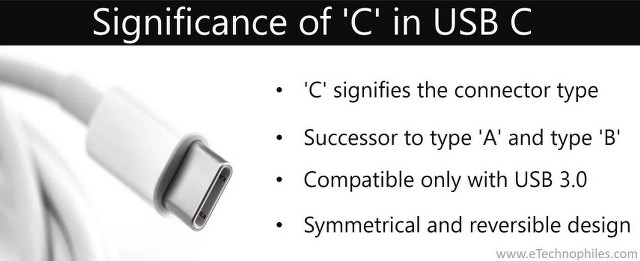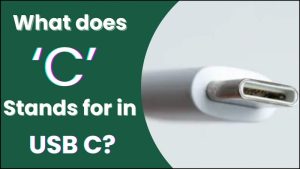USB technology has drastically evolved in terms of speed, size, connector size, compatibility, etc. USB has become a mandatory factor in day-to-day life now. Either for interconnecting devices or for power supply applications, we use a USB connection numerous times. The introduction of USB A, USB B, and USB C is an example. What does this tail-end alphabet actually represent? Let’s Discuss.

So, what does C mean in USB C?
The letter ‘C’ literally does not have an expansion. ‘C’ just signifies the connector type of the USB that is characterized by its reversible design, allowing users to plug it in either way. The Type C connector is the latest in the series of USB connectors. Type A and Type B are the preceding connector types.
Hence, it supports high data speeds and has a small and symmetric connector shape.
Table of Contents
Why are there so many USB types?
USB stands for Universal Serial Bus. They are widely used protocols for communication between devices as well as for power supply in portable devices. It was introduced in 1995. It has been evolving since then.
USB was introduced as the USB 1.0 standard, which was then upgraded to USB 1.1, USB 2, and USB 3. Another classification is based on the connector type. USB A, USB B, and USB C are the available connector types in USB.
USB A and USB B were the initial USB connector types introduced. Among them, computers use USB A ports, and peripheral devices use USB B ports. Hence, USB A to USB B was the standard cable. With the introduction of USB C (in the USB 3.0 generation), most devices started to adapt to it due to its numerous advantages. Its small and symmetrical connector shape was highly utilized by small-sized devices.
Significance of ‘C’ in USB-C

USB C is the connector type popularly known as the most user-friendly connector. The major reason for this title is its symmetrical connector shape. Due to this, we need not care about the direction of the connector while plugging into the port. Unlike older USB connectors like USB-A and USB-B, which have a specific orientation.
Hence, it goes well in any direction, while the other connectors should be careful while inserting them into the port. Otherwise, it will result in damage.
The smaller and more compact connector shape is another prominent benefit of USB C. This is a major feature in this age of small devices. The USB C ports are extensively used on small devices so that they do not consume more port space.
As a member of USB Generation 3.0, USB C falls under the high-speed data transfer type. This added to the advantages, which made USB C one of the most significant and wanted USBs today.
What do C, B, and A mean in USB C, B, and A?
Regardless of the abbreviation USB, the letters C, B, and A do not carry any expansion. They denote the connector’s “Type”. The letter also stands for the “form factor” of the connector.
The “Type” represents the physical design of the connector/port, including its size and shape. It is also used to represent the USB cable. USB A and USB B are compatible with USB 1.1 and USB 2.0, whereas USB C is compatible only with USB 3.0 and beyond.
Each USB type has its own significance. Let’s see.
USB A

USB A is the largest among all the USB types. It has a flat-rectangular shape. The major application is connecting peripheral devices with the computer. A limitation is that the USB A connector is not found in modern devices.
USB B

USB B is the port for peripheral devices on the computer, such as printers, mouse, scanners, etc. They are smaller than USB A and are square in shape.
USB C

USB Type C rules among the three types. The symmetric, round-edged shape and compact size of the connector have drastically increased its popularity. They are widely used in high-speed data transmission.
How can we determine the ‘Type’ of a USB cable?
It is evident that the USB cable is named according to its connector head at the ends. But what if both ends have different types of connectors on a USB cable? Then the USB cable is addressed with the latest connector type.
For example, if one end of the cable is a USB C connector and the other end is a USB A connector, the cable is known as a USB C cable.
What are the other types of USB?
Apart from USB A, USB B, and USB C, USB Mini, USB Micro, and Lightning cables are the other types of USB. These are the smaller and more compact versions of types A, B, and C. USB A and USB B have their own mini versions of connectors.
Micro USB A and Micro USB B are the available Micro connector types. Hence, Micro and Mini are the two subtypes of USB A and USB B. Lightening cable is another enhanced connector type among USBs. They are used in Apple devices.
Conclusion
The letters A, B, and C in USB A, USB B, and USB C denote the form factor of the connector. They do not carry any abbreviations. We can say that each update is named according to alphabetical sequence. A is the oldest USB Type, and C is the latest model on the market.
